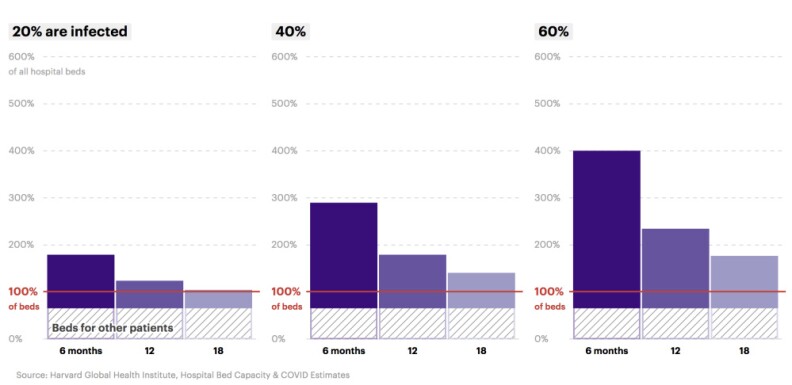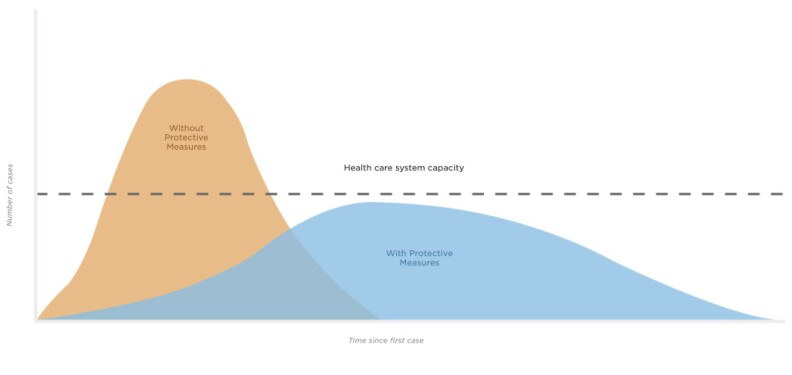With our free press under threat and federal funding for public media gone, your support matters more than ever. Help keep the LAist newsroom strong, become a monthly member or increase your support today .
An ER Doctor Wonders If California's Stay At Home Order Is 'Too Little, Too Late'

By Leila Fadel | NPR
California Gov. Gavin Newsom took the dramatic step this week of ordering the state's nearly 40 million residents to stay at home. That order on Thursday was followed by similar orders in states including New York, Illinois and Nevada.
These were actions welcomed by health care professionals who are trying to prepare hospitals even in the midst of the pandemic, as they watch the Italian hospitals buckle under the demand of the fast-spreading virus.
"I think the stay at home order is necessary and I think it should be done across the nation," said Haig Aintablian, president of the American Academy of Emergency Medicine Resident and Student Association. He's a Southern California-based, emergency department resident. "But I wonder if that might be too little, too late. Because this virus is showing symptoms so much later."
So, he says, it may have spread too widely already. There is still a national shortage in testing so that's an unknown.
MEDICAL SUPPLIES IN SHORT SUPPLY
Meanwhile health care workers across the country are sounding alarms about a shortage in personal protective gear for health care workers as the cases multiply.
Aintablian said he's hearing from doctors and residents in California that supplies are low at some hospitalsand in a few cases could be depleted in two weeks. Meanwhile the Centers for Disease Control and Prevention guidance keeps changing, including suggesting using a bandana or homemade mask in a crisis when no face mask is available.
"It's almost ridiculous from our perspective because we need to be the most protected, because if we get sick, we're a hazard to our other patients because we could get them infected," Aintablian said. "If we're not there to fight this battle, who is?"
Especially because, up to this point, he said, so many people haven't taken the quarantine seriously and the virus is spreading. Until late this week hiking trails and parks were crowded with people in the Los Angeles area and over the past week retail stores were generally open.
"My biggest concern is the safety of all of us in the emergency department. If one of us goes down, then it has a toppling effect on everyone else, and we're not able to stop that unless we have really good protective gear on throughout our shifts," Aintablian said.
BIG STATE, BIG RISKS
California is the country's most populous state. The governor says if the spread of the disease is left unchecked more than half of the state would be infected in two months based on certain models. There are over 1,000 confirmed cases in California and at least 20 deaths.
The state, municipalities, counties and hospitals are scrambling to ready themselves in the midst of a pandemic. Newsom said the state has about 75,000 licensed hospital beds and he estimates at surge capacity it would have 88,000. Newsom also said the state has about 11,400 intensive-care unit beds, both for adults and children. Other estimates put that lower.
But if the infection rate does meet that worst-case scenario projection, he said the hospitals will be nearly 20,000 beds short for the wave of people that will need to be hospitalized.

The state is working to get more beds. It's leasing a hospital in Northern California that was on the verge of closing, Seton Medical Center in Daly City. It's acquiring another hospital in southern California. It's also in talks to lease motels, hotels and university dormitories for use during the pandemic. The state legislature passed an emergency funding bill of $1.1 billion earlier this week.
Individual hospitals and networks have been getting ready for weeks and are working in coordination with the wider city, county and state system.
Johnese Spisso, the head of UCLA's hospitals, said the system's leaders started planning in January when they saw the spread begin.
The system contains an academic medical center and Level-1 trauma center with four hospitals and about 180 clinics. They set up a command center that started meeting daily by February and they had tents pitched outside the medical center by the first week of March to screen patients.
TESTING SO FAR
They've gone from doing 40 tests a day to 100. Next week Spisso hopes to be up to 500 with federal support and changes the FDA is making. Not enough, she said, but better.
"We definitely would like to be doing as many of the tests as possible here in Los Angeles. We're a big county," she said. "We have 10 million people. So we want to make sure that we and other hospitals and health systems are really working together to make sure we can begin flattening the curve."
Now the system is looking at getting more ICU bed capacity by converting in-patient beds and moving patients with less severe symptoms to other sites. Administrators are trying to stock up on personal protective gear and ventilators, and train additional staff.
"We feel that we are prepared. You know, we've all had some time to watch what was happening in other countries and kind of look to the future," she said.
The system is planning, she said, for the worst-case scenario, looking at where to put satellite tents to house patients, where buildings can be converted to hospital use, and constantly assessing if there are enough ventilators and staff, and how to work with other hospitals and health systems to get everyone what they need.

"But we need everybody's help. We can't do it alone. As the health system, we need the public to be strictly adhering to these guidelines," she said.
Because if the curve isn't flattened?
"The exponential increase is something that we can't get ahead of," Spisso said.
Copyright 2020 NPR. To see more, visit NPR.

SOME STRAIGHT TALK ABOUT COVID-19
We're all living through this extraordinary and frightening pandemic. The vast majority of our newsroom has been working from home (here's some advice on that) since March 11 to bring you calm, helpful reporting. We are answering your questions and taking more.
We're here to help. And if you can help support that effort financially, we'd be grateful.
DON'T MISS ANY L.A. CORONAVIRUS NEWS
Get our daily newsletter for the latest on COVID-19 and other top local headlines.
Terms of Use and Privacy Policy
Support our free, independent journalism today. Donate now.
At LAist, we believe in journalism without censorship and the right of a free press to speak truth to those in power. Our hard-hitting watchdog reporting on local government, climate, and the ongoing housing and homelessness crisis is trustworthy, independent and freely accessible to everyone thanks to the support of readers like you.
But the game has changed: Congress voted to eliminate funding for public media across the country. Here at LAist that means a loss of $1.7 million in our budget every year. We want to assure you that despite growing threats to free press and free speech, LAist will remain a voice you know and trust. Speaking frankly, the amount of reader support we receive will help determine how strong of a newsroom we are going forward to cover the important news in our community.
We’re asking you to stand up for independent reporting that will not be silenced. With more individuals like you supporting this public service, we can continue to provide essential coverage for Southern Californians that you can’t find anywhere else. Become a monthly member today to help sustain this mission.
Thank you for your generous support and belief in the value of independent news.

-
Immigration raids have caused some U.S. citizens to carry their passports to the store, to school or to work. But what documents to have on you depends on your citizenship.
-
The historic properties have been sitting vacant for decades and were put on the market as-is, with prices ranging from $750,000 to $1.75 million.
-
Users of the century old Long Beach wooden boardwalk give these suggestions to safely enjoy it.
-
The Newport Beach City Council approved a new artificial surf park that will replace part of an aging golf course.
-
The utility, whose equipment is believed to have sparked the Eaton Fire, says payouts could come as quickly as four months after people submit a claim. But accepting the money means you'll have to forego any lawsuits.
-
The City Council will vote Tuesday on a proposal to study raising the pay for construction workers on apartments with at least 10 units and up to 85 feet high.







